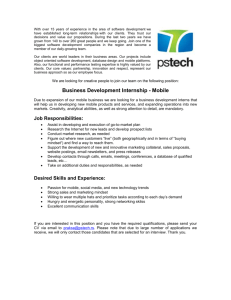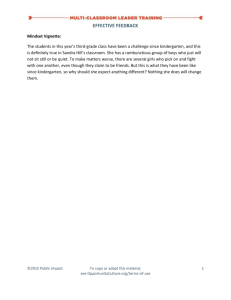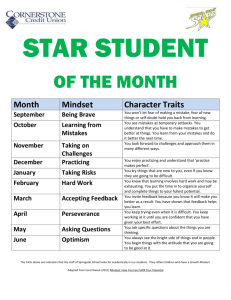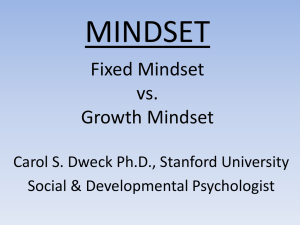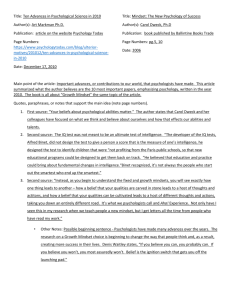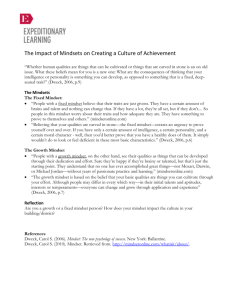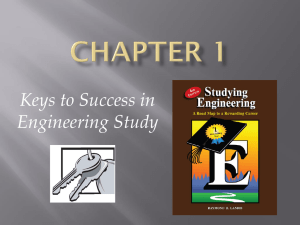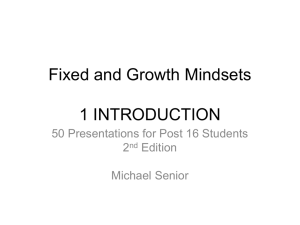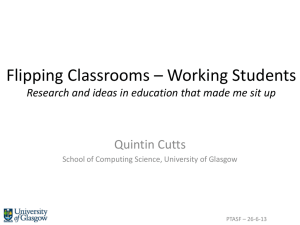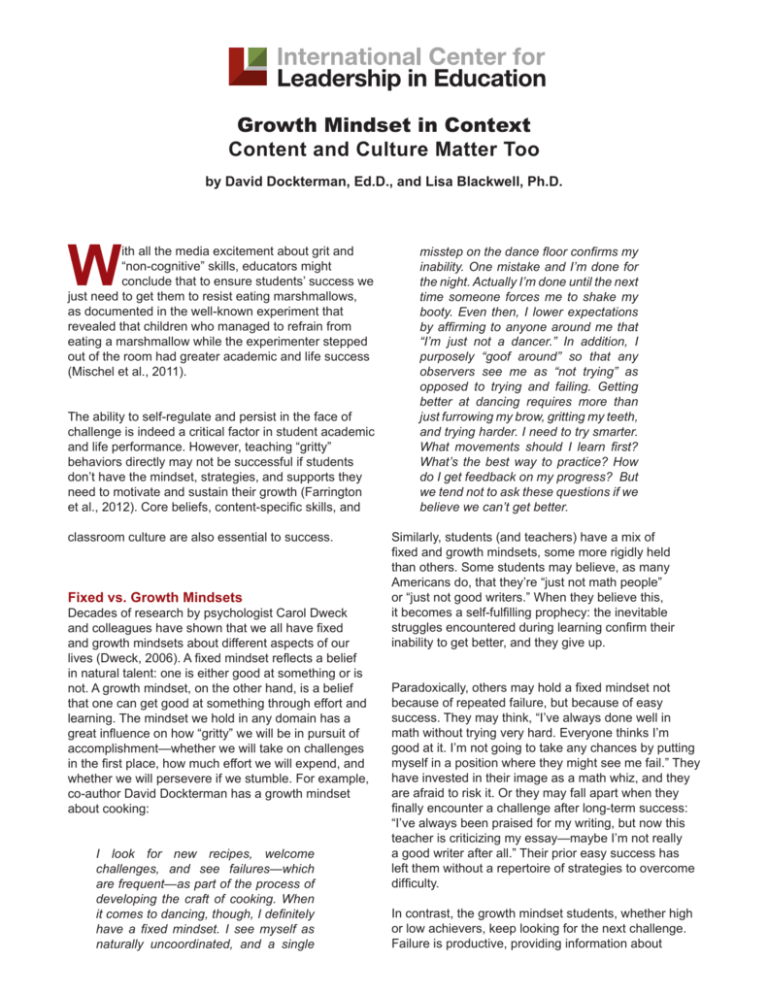
Growth Mindset in Context
Content and Culture Matter Too
by David Dockterman, Ed.D., and Lisa Blackwell, Ph.D.
W
ith all the media excitement about grit and
“non-cognitive” skills, educators might
conclude that to ensure students’ success we
just need to get them to resist eating marshmallows,
as documented in the well-known experiment that
revealed that children who managed to refrain from
eating a marshmallow while the experimenter stepped
out of the room had greater academic and life success
(Mischel et al., 2011).
The ability to self-regulate and persist in the face of
challenge is indeed a critical factor in student academic
and life performance. However, teaching “gritty”
behaviors directly may not be successful if students
don’t have the mindset, strategies, and supports they
need to motivate and sustain their growth (Farrington
et al., 2012). Core beliefs, content-specific skills, and
classroom culture are also essential to success.
Fixed vs. Growth Mindsets
Decades of research by psychologist Carol Dweck
and colleagues have shown that we all have fixed
and growth mindsets about different aspects of our
lives (Dweck, 2006). A fixed mindset reflects a belief
in natural talent: one is either good at something or is
not. A growth mindset, on the other hand, is a belief
that one can get good at something through effort and
learning. The mindset we hold in any domain has a
great influence on how “gritty” we will be in pursuit of
accomplishment—whether we will take on challenges
in the first place, how much effort we will expend, and
whether we will persevere if we stumble. For example,
co-author David Dockterman has a growth mindset
about cooking:
I look for new recipes, welcome
challenges, and see failures—which
are frequent—as part of the process of
developing the craft of cooking. When
it comes to dancing, though, I definitely
have a fixed mindset. I see myself as
naturally uncoordinated, and a single
misstep on the dance floor confirms my
inability. One mistake and I’m done for
the night. Actually I’m done until the next
time someone forces me to shake my
booty. Even then, I lower expectations
by affirming to anyone around me that
“I’m just not a dancer.” In addition, I
purposely “goof around” so that any
observers see me as “not trying” as
opposed to trying and failing. Getting
better at dancing requires more than
just furrowing my brow, gritting my teeth,
and trying harder. I need to try smarter.
What movements should I learn first?
What’s the best way to practice? How
do I get feedback on my progress? But
we tend not to ask these questions if we
believe we can’t get better.
Similarly, students (and teachers) have a mix of
fixed and growth mindsets, some more rigidly held
than others. Some students may believe, as many
Americans do, that they’re “just not math people”
or “just not good writers.” When they believe this,
it becomes a self-fulfilling prophecy: the inevitable
struggles encountered during learning confirm their
inability to get better, and they give up.
Paradoxically, others may hold a fixed mindset not
because of repeated failure, but because of easy
success. They may think, “I’ve always done well in
math without trying very hard. Everyone thinks I’m
good at it. I’m not going to take any chances by putting
myself in a position where they might see me fail.” They
have invested in their image as a math whiz, and they
are afraid to risk it. Or they may fall apart when they
finally encounter a challenge after long-term success:
“I’ve always been praised for my writing, but now this
teacher is criticizing my essay—maybe I’m not really
a good writer after all.” Their prior easy success has
left them without a repertoire of strategies to overcome
difficulty.
In contrast, the growth mindset students, whether high
or low achievers, keep looking for the next challenge.
Failure is productive, providing information about
what to do differently next time. Their belief that the
next try has a chance of success is what fuels their
perseverance, and over time, this results in higher
achievement (Blackwell et al., 2007).
will be. Most surprisingly, even apparently positive
words of praise can subtly undermine students’
grittiness.
Developing a Growth Mindset
Pioneering research by Claudia Mueller and Carol
Dweck first showed how a simple sentence of
feedback, praising students either for intelligence or
for effort, could shift their mindset and performance.
Students praised for being “smart” after a good
performance were less likely to choose a challenging
task afterward, and when they did encounter a failure,
their performance plummeted. Those praised for effort
overwhelmingly chose to try something harder, and
their performance improved following a failure (Mueller
and Dweck, 1998).
Importantly, mindset is not a fixed attribute. Like other
beliefs, it is learned from experience and instruction.
Intervention studies show that students’ motivation,
perseverance and achievement can be increased
by teaching a growth mindset (Aronson et al., 2001;
Blackwell et al., 2007; Good et al., 2003).
For example, co-author Lisa Blackwell and her
colleague Carol Dweck taught a workshop to a
struggling group of middle school math students in
New York City. One version of the workshop included
lessons about how the brain learns and grows smarter
with effort, along with study strategies. A control group
received general information about the brain and the
same study strategy information. The students who
received the growth mindset message improved their
grades, and were rated by their teachers as showing
more positive motivation to learn, while their peers who
did not learn that message continued to show declining
grades and low motivation (Blackwell et al., 2007). The
study strategies alone weren’t enough to improve their
performance. Students need to know how to get better,
AND they need to believe that exercising those skills
will pay off.
However, mindset is not entirely an individual matter.
It is continually influenced by peers, teachers, parents,
and the wider culture. As educators, what can we do
to help our students cultivate a growth mindset in our
schools and classrooms?
Creating a Growth Mindset Culture
Every day in our classrooms and schools, students’
mindsets are being molded by the messages that we
give them. It isn’t easy to make mistakes, to struggle,
and to accept criticism in front of others. Failure
often comes with both a personal sting and a social
embarrassment. While a natural part of the learning
process, it still hurts.
Fortunately, students with a growth mindset and a solid
sense of self-efficacy know how to use each failure
productively. The personal sting is only temporary, and
the next, thoughtful try is quickly underway. The social
embarrassment, on the other hand, emerges from the
interaction between the student and his or her peers,
teachers, and others. No one wants to look dumb or
perform poorly—even at non-essential things such as
dancing.
The way that teachers, peers, and parents talk to
students influences how resilient and persevering they
Thus, counterintuitively, praising intelligence—“You
must be smart”—actually makes children fragile. (Bad
news for grandparents everywhere!) On the other
hand, praising effort and hard work focuses students on
learning and creates “gritty,” resilient learners.
Peer culture and identity are also important factors in
students’ sense of self-efficacy. Joshua Aronson and
others got a bump in performance by making sure
students associated themselves with a group of high
achievers, avoiding the negative effects of stereotype
threat (Aronson, et al, 2002; Good, et al, 2003).
How teachers and peers react to mistakes also
influences how well a growth mindset can be sustained
in the classroom. Steuer and others have identified
characteristics of what they call “error climate,”
important elements of the classroom environment that
can hinder or promote risk-taking and a student’s ability
to sustain a sense of self-efficacy (Steuer, et al, 2013).
How, for instance, does the teacher treat mistakes? Do
students feel that mistakes in a classroom discussion
will hurt their grades? How do classmates respond to
the mistakes and academic successes of their peers?
Maintaining a sense of belonging is a fundamental
driver of human motivation. If we want to nurture a
growth mindset, we need classroom, school, and
community cultures that reflect the language and
expectations that come with it.
Teaching a growth mindset, using appropriate praise,
providing examples of how genius is the result of hard
work, having students write about how their learning
connects to their lives, and other techniques have
all shown promise in getting students to believe that
they can succeed. (For an excellent review of these
interventions, see Yeager and Walton, 2011). Without
that belief, students have no reason to try.
These interventions, though, did not magically give
students knowledge and skills they didn’t already
possess. Instilling a growth mindset heading into a
course or year of study makes students more open
to learning, more tolerant of mistakes, and more
willing to try again when they fail. Removing negative
associations before a performance, such as a test,
reduces anxiety that might restrict working memory and
promotes focus and perseverance. Students are able
to do more with what they have.
However, some students, particularly ones with a
long history of failure, may need additional evidence
that their effort will be worthwhile. Here we can take
a cue from the way video games purposefully and
thoughtfully ramp up the difficulty level. Start hard and
players are more likely to quit; provide some early
success and players are much more likely to stick with
the game, even as it gets more and more challenging.
What that ramp up looks like for a topic in math, a
writing assignment, or a complex science chapter will
be dependent on the specific nature of the content. In
all cases, though, ramp up serves two important goals:
1. Build confidence in the domain: “I can learn
math,” “I can get better at writing,” “I can come
to understand this science”
2. Keep the challenges coming.
With an appropriate level of challenge, students are
motivated to persevere and try again. But, like David
with his dancing skills, how do students know what to
do on that next try?
Providing Smart Strategies for Perseverance
With one challenge following another, all students
are bound to hit a wall. Generic study and problemsolving strategies can help, and following the research
can make students much more efficient learners. Hal
Pashler and others, for instance, have done a good job
of identifying techniques that work and those that aren’t
so successful (Rohrer and Pashler, 2010). Cramming,
for instance, may fill short-term memory, but most of
what has been crammed is quickly forgotten. Spaced
repetition and practice tests, on the other hand, work
well in building long-term knowledge. Let’s make sure
we share and support these approaches with our
students.
Each domain and even problem type may require
different strategies to tackle difficult tasks. What should
a student who can’t seem to get started writing a paper
do to persevere? What about the pupil stuck on a math
word problem or struggling through a reading passage?
When would it be helpful to make a list, draw a picture
or even take a break? What can the student do to learn
from prior attempts and the attempts of others when it
comes to writing, comprehending or calculating?
Students with a growth mindset are primed to seek
and learn the strategies and background knowledge
that will facilitate their success. Carrying a growth
mindset mentality into instruction can help. Modeling
and sharing reasoning for why each step is followed or
strategy employed fosters reflection and gives students
thinking tools that can be used again and again.
Encourage each student to think about his or her brain
and consider the actions that can assist it to learn and
grow. Multitasking is distracting. Working memory is
limited. Lack of sleep hampers the ability to focus and
consolidate. And remember that it’s OK to let students
fail, but we need to provide the mechanisms for them to
learn from any failures.
The Brainology® curriculum, developed by Carol Dweck,
Lisa Blackwell, and colleagues at Mindset Works,
teaches both the foundations of a growth mindset and
the learning strategies to support growth. Modeled on
the successful mindset workshop tested in Blackwell et
al., 2007, Brainology teaches students that their brains
are like a muscle that gets stronger with exercise, and
how to do so. Addressing challenges such as focusing
attention, managing stress, learning new content and
building memory, it provides students with strategies
for helping their brains to get stronger and perform
well. The message that intelligence is malleable and
learning leads to physical and functional brain change
provides a concrete and practical way to understand
and practice a growth mindset. Concepts, language,
and tools that teachers can use to reinforce a growth
mindset in daily lessons help create a classroom
culture that supports learning. Scholastic’s MATH 180
curriculum has also embedded growth mindset frames
and feedback into print and online activities.
Next Steps
Embedding growth mindset in a school or classroom
culture includes embedding it into the curriculum.
Instruction should reflect the language, strategies,
and expectations of effortful learning, risk-taking,
and productive failure. Students need to learn how
to persevere in smart and strategic ways, ways that
may be different from one content area to another.
And teachers and peers need to commit to the culture,
as well reinforce and reward resilient behavior. It’s a
challenge, but those of us with a growth mindset seek
them out.
Aronson, J., Fried, C. B., & Good, C. (2002).
Reducing the effects of stereotype threat on African
American college students by shaping theories
of intelligence. Journal of Experimental Social
Psychology, 38, 113-125.
Mischel, W., Ayduk, O., Berman, M., Casey, B. J.,
Gotlib, I., Jonides, J., Kross, E., Teslovich, T., Wilson,
N., Zayas, V., & Shoda, Y. (2011). ‘Willpower’ over the
life span: decomposing self-regulation. Social Cognitive
and Affective Neuroscience, 6 (2): 252-256.
Blackwell, L., Trzesniewski, K., & Dweck, C.S. (2007).
Implicit theories of intelligence predict achievement
across an adolescent transition: A longitudinal study
and an intervention. Child Development, 78. 246-263.
Mueller, C. & Dweck, C. Praise for intelligence can
undermine children›s motivation and performance.
Journal of Personality and Social Psychology, 75 (1),
Jul 1998, 33-52.
Dweck, C. Mindset: The New Psychology of Success.
New York: Random House, 2006.
Rohrer, D. & Pashler, H. (2010). Recent Research on
Human Learning Challenges Conventional Instructional
Strategies. Educational Researcher , 39, 406-412.
Good, C., Aronson, J., & Inzlicht, M. (2003). Improving
adolescents’ standardized test performance: An
intervention to reduce the effects of stereotype
threat. Applied Developmental Psychology, 24, 645662.
Steuer, G., Rosentritt-Brunn, G., & Dresel, M. Dealing
with errors in mathematics classrooms: Structure and
relevance of perceived error climate. Contemporary
Educational Psychology, 38 (2013) 196-210.
Farrington, C.A., Roderick, M., Allensworth, E.,
Nagaoka, J., Keyes, T.S., Johnson, D.W., & Beechum,
N.O. (2012). Teaching adolescents to become learners.
The role of noncognitive factors in shaping school
performance: A critical literature review. Chicago:
University of Chicago Consortium on Chicago School
Research.
About the Authors
David Dockterman, Ed.D. is Chief Architect, Learning Sciences at Scholastic Education and an Adjunct
Lecturer at the Harvard Graduate School of Education. Lisa Blackwell, Ph.D. is co-founder and VP of
Design, Implementation, and Evaluation at Mindset Works.
Copyright © July 2014 by International Center for Leadership in Education. All rights reserved.
References

